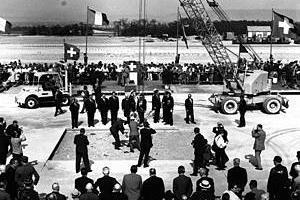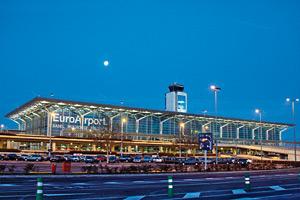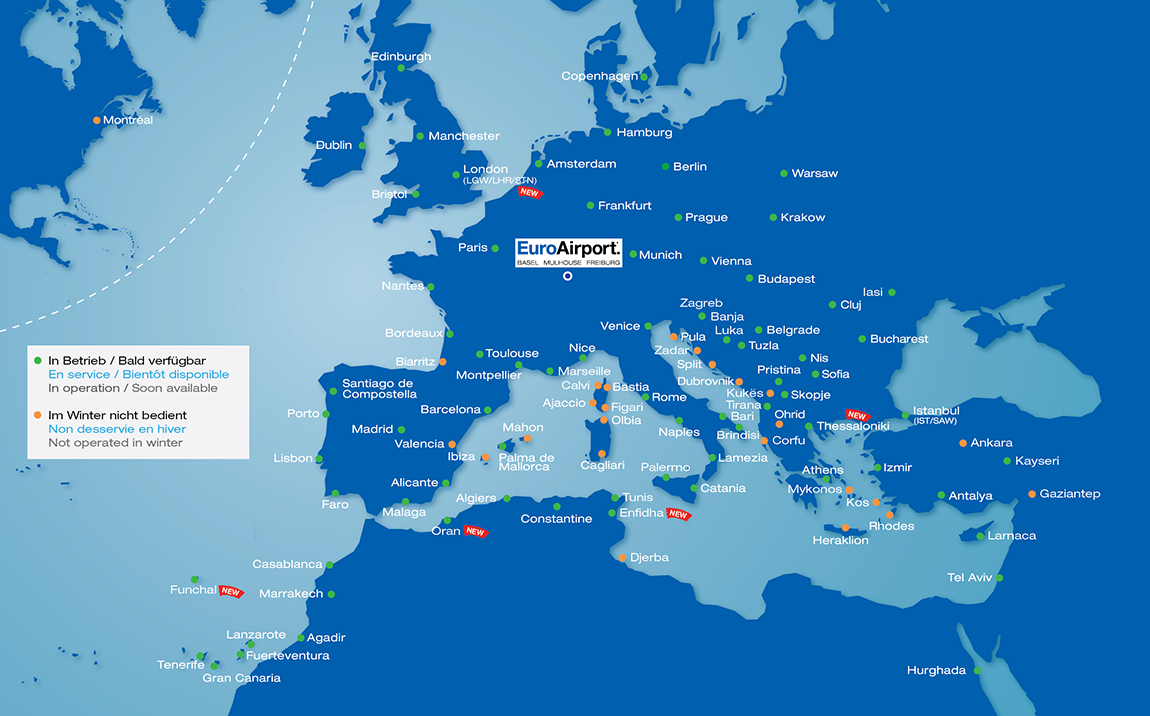EuroAirport - Serving the needs of the RegioTriRhena
From the first stone in 1946...

to today and tomorrow...

History of the airport
The first Basel-Mulhouse airport infrastructure was constructed within two months and inaugurated on 8th May, 1946, after the first civilian aircraft had landed there a few days before on 2nd May.
The Basel-Mulhouse airport, known under its trademark EuroAirport Basel-Mulhouse-Freiburg, is a symbol for the international co-operation which became absolutely vital after the Second World War.
Plans for the Basel-Mulhouse Airport, however, go back even further to the 1930s when the authorities of the cantons of Basel-Stadt and Baselland realized that the Basel-Sternenfeld airfield would soon become too small due to the increase in air traffic and the use of new planes like the DC-3.
At that time the French government had given the go-ahead for a project on the border between Allschwil and Burgfelden. But once the Second World War had broken out, negotiations were suspended.
They were resumed in May 1945 and eventually led to a basic agreement according to which France was to provide the land and Switzerland to build the runways and airport buildings. Without waiting for the signing of the Swiss-French treaty on 4th July, 1949 in Berne, the authorities decided to start building the first provisional infrastructure.
In the following years they pressed ahead with the extension of the airport. In 1951-52 the Swiss customs-free road connecting Basel city directly to the airport was built, in December 1952 the 1,600 meters long east/west runway was completed and a year later the 2,370 meters long main north/south runway was put into use. After the runways and air traffic control equipment had been provided, the major buildings were erected: the airport buildings were completed in 1966, the cargo warehouses became operational in May 1970 and on 27th June, 1970 the then "finished" airport was inaugurated.
Since then the existing infrastructure has been systematically expanded and rebuilt according to need. In 1978 the main runway was extended to 3,900 meters in order to allow unrestricted takeoff and landing by all types of aircraft. The extension of the cross runway by 220 meters followed in 2001. In 1979-81 the cargo hall, including the office wing was enlarged. In 1988 a provisional hall for the upcoming express and courier freight was added and replaced by the final "West End" in 1996. The old cargo hall was replaced by a modern new freight terminal in zone 4 in the south east of the airport in the year 2015. It is adapted to the needs of the local industry, particularly pharmaceutical firms.
In the Passenger Terminal in 1990 the departure halls were redesigned and further aircraft bays leading directly to the terminal were created through the addition of a finger dock. In 2000-2001 this finger dock was extended to form the present Y-shaped dock with about 25 aircraft stands. Similarly, in order to cope with the steadily increasing numbers of passengers, the terminal was considerably enlarged and modernized on the land side; at the end of 2002 the extension of the French part was opened, followed by the Swiss part in the summer of 2005. The still existing old middle part of the terminal was rebuilt by early 2013 and its appearance adapted to that of the modern new buildings; the renewed Hall 2 in the French part already came into service again in the summer of 2011.
Important milestones
1946 - After two months of building, the provisional airport is inaugurated
1949 - Franco-Swiss treaty signed in Berne
1952 - Opening of toll-free road between Basel and the airport
1966 - Completion of hangars with workshops and office wing
1970 - Inauguration of the passenger terminal with a capacity of 1 million passengers per year
1978 - Extension of the main runway to 3,900 m
1984 - The airport passes the 1-million-passenger mark for the first time
1987 - Launch of the EuroAirport Basel-Mulhouse-Freiburg brand
1992 - The airport passes the 2-million-passenger mark for the first time
1996 - Award as Europe’s best regional airport
1998 - 3-million-passenger mark passed for the first time
1999 - Foundation stone laid for new finger dock
2002 - Inauguration of the North Passenger Terminal
2005 - Inauguration of the South Passenger Terminal
2006 - 4 million passengers for the first time; green light for expansion of the south zone
2008 - The south west "6bis" zone (aircraft maintenance and outfitting) with wide-body hangars became operational
2011 - 5 million passengers for the first time
2012 - Renovation of the old part of the Airport Terminal
2014 - The airport passes the 6-million-passenger mark for the first time
2015 - 7 million passengers for the first time; inauguration of the new Cargo Terminal
2017 - Inauguration of the new F4 multi-storey car park with 2,700 parking spaces
2018 - 8 million passengers for the first time
2019 - 9 million passengers for the first time
2020 - Unprecedented coronavirus crisis, traffic drops to 2.6 million passengers
EuroAirport today
The extremely convenient location of EuroAirport at the heart of Western Europe and at the crossroads of three economically thriving regions (Alsace, North West Switzerland and Baden-Württemberg) explains the airport’s success. EuroAirport is the best equipped airport on the Upper Rhine and, thanks to its infrastructure, can cope with any kind of traffic.
9.1 million passengers have used EuroAirport in 2019. The scheduled flight network includes around 100 airports in more than 30 different countries. Normally they can be reached directly several times a week or daily without changing.
In 2020, passenger volume dropped to 2.6 million due to the global pandemic crisis. Despite this context, EuroAirport has maintained an offer of more than 80 destinations throughout Europe and the Mediterranean basin.
At EuroAirport more than 25 different airlines handle the scheduled flights. The market leaders are easyJet and Wizz Air, followed by Sun Express, Enter Air and Turkish Airlines. The presence of the leading international airline alliances Star Alliance, SkyTeam and oneworld, which offer connections to their hubs in London, Paris, Frankfurt, Munich, Amsterdam, Madrid, Istanbul, Barcelona and Vienna several times a day, provides the passenger with optimum access to all the European intercontinental hubs.
EuroAirport is not just a gateway to the world, but also a gateway to the trinational region for all those who visit. In 2016, approx. 1 million passengers were incoming tourists. This potential can be further developed by means of specific regional tourism promotion.
In the business of aircraft maintenance and outfitting, EuroAirport, with the local firms Jet Aviation, AMAC Aerospace, Air Service Basel and Nomad Aviation, is also one of the world’s leading competence centres for better-class business and private aviation.
Network

(Data subject to change)
Outlook for the future
The range of services offered by EuroAirport will continue to develop. In the passenger sector there are prospects of extending the Eastern European connections, of optimizing the range of classical business destinations and holiday flights as well as of diversifying the choice of flights through attracting additional airlines.
In the freight sector the old freight hall is rebuilt to meet the needs of express freight, and the express freight activities will be united in one building.
Another important project for EuroAirport and the region is the direct railway connection to the airport. This project was officially revived by the French government at the beginning of 2010. The association EAP EXPRESS, which was set up in October 2010, is promoting the project with different measures to enable travellers and staff to reach the airport more easily.
Another future construction project is the erection of a hotel with 200 rooms in immediate proximity to the Airport Terminal.